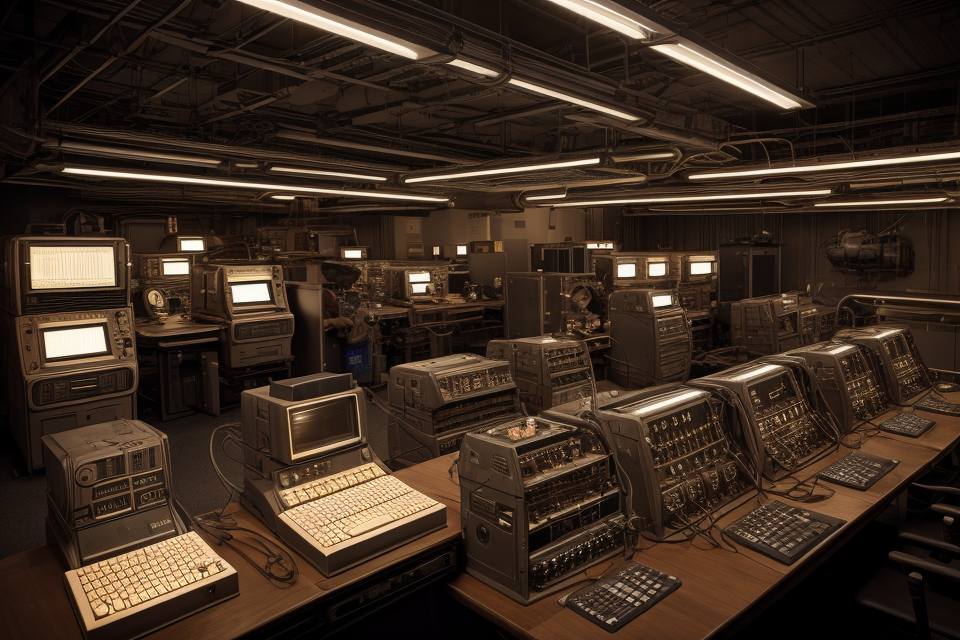In the early days of space exploration, NASA relied heavily on human computers to calculate complex mathematical equations and ensure the success of their missions. These women, known as the “human computers,” were vital to NASA’s success, but their contributions were often overlooked and undervalued. This talk will explore the role of the human computers in NASA’s history and the impact they had on the agency’s success. From calculating trajectories to monitoring spacecraft systems, the human computers played a crucial role in NASA’s early achievements and paved the way for future space exploration.
The Origins of Human Computers at NASA
The Role of Women in NASA’s Early Years
The role of women in NASA’s early years was significant and crucial to the success of the space program. During the 1950s and 1960s, when NASA was first establishing itself as a leader in space exploration, women were heavily involved in computing and mathematical work. These women, who were referred to as “human computers,” played a vital role in the success of NASA’s early missions.
One of the main reasons why women were hired as human computers was due to the shortage of men with mathematical and scientific skills following World War II. As a result, NASA and other organizations in the aerospace industry turned to women to fill these positions. However, despite their significant contributions, women were often undervalued and underappreciated.
The work of human computers at NASA involved performing complex calculations and mathematical modeling. They were responsible for computing trajectories, determining propulsion needs, and analyzing data from experiments. Women were also instrumental in developing the software that was used to control the spacecraft during missions.
Despite the challenges they faced, including limited opportunities for advancement and unequal pay, women continued to work as human computers throughout NASA’s early years. They played a critical role in the success of the Apollo missions, which ultimately led to the first human landing on the moon in 1969.
In conclusion, the role of women as human computers in NASA’s early years was crucial to the success of the space program. Despite facing numerous challenges, these women demonstrated their mathematical and computational skills, which were essential to the advancement of space exploration.
The Skills Required of Human Computers
In the early days of NASA, human computers played a crucial role in the success of the space program. These individuals were responsible for performing complex calculations and data analysis by hand, using only pen and paper. To be a successful human computer, one had to possess a unique set of skills.
- Attention to Detail: Human computers had to be meticulous in their work, ensuring that every calculation was accurate and precise. This required a high level of concentration and focus, as even small errors could have significant consequences.
- Quick Calculation Abilities: Given the time-sensitive nature of the work, human computers needed to be able to perform calculations quickly and efficiently. This required a deep understanding of mathematical concepts and the ability to work under pressure.
- Analytical Thinking: In addition to performing calculations, human computers were also responsible for analyzing data and identifying patterns. This required a strong analytical mindset and the ability to think critically and logically.
- Communication Skills: Human computers often worked in teams, and effective communication was essential for success. Individuals needed to be able to clearly convey their findings and work collaboratively with others.
- Adaptability: As technology advanced, human computers needed to be able to adapt to new methods and tools. This required a willingness to learn and a flexibility in approach.
Overall, the skills required of human computers at NASA were diverse and challenging. Those who possessed these skills played a critical role in the success of the space program, and their contributions are still felt today.
NASA’s Reliance on Human Computers
Calculating Flight Paths and Orbit Trajectories
NASA’s early human computers played a crucial role in calculating the precise flight paths and orbit trajectories necessary for successful space missions. These skilled mathematicians were responsible for solving complex equations and developing algorithms that enabled NASA to navigate its spacecraft with incredible accuracy.
One of the most challenging tasks faced by human computers was calculating the precise trajectory of a spacecraft during launch. This required a deep understanding of gravity, orbital mechanics, and the physics of propulsion systems. By inputting data on the mass of the spacecraft, the strength of the launch vehicle, and the conditions of the launch environment, human computers could calculate the precise angle and speed required for a successful launch.
Once a spacecraft was in orbit, human computers were responsible for calculating its trajectory and ensuring that it remained on course. This required the use of sophisticated mathematical models that could predict the gravitational forces of the Earth, the Moon, and other celestial bodies. Human computers also had to account for the effects of solar radiation and other environmental factors that could impact the trajectory of a spacecraft.
To achieve this level of precision, human computers used a variety of tools and techniques, including analog computers, slide rules, and mechanical calculators. They also relied on complex algorithms and mathematical models that had been developed over many years of research and experimentation.
Despite the incredible complexity of their work, human computers played a critical role in NASA’s success. Their skills and expertise helped to ensure that spacecraft were launched and operated with the highest degree of accuracy and precision, paving the way for many groundbreaking discoveries and achievements in space exploration.
Supporting the Apollo Moon Landing Missions
Human computers played a crucial role in supporting NASA’s Apollo Moon Landing Missions. These skilled individuals were responsible for performing complex calculations and data analysis that helped ensure the success of the missions. They worked tirelessly, often under intense pressure, to ensure that the astronauts had the most accurate information possible to guide them on their journey.
One of the primary tasks of the human computers was to calculate the complex trajectories required for the spacecraft to reach the Moon. This involved solving complex equations and making precise calculations based on the position of the Earth, the Moon, and the Sun. These calculations were critical to ensuring that the spacecraft would arrive at the Moon at the right time and in the right place.
In addition to calculating trajectories, the human computers were also responsible for analyzing data collected during the missions. They would monitor the spacecraft’s systems, track the astronauts’ progress, and analyze data collected from various instruments. This data was used to make critical decisions about the mission, such as when to deploy the lunar module or when to perform a spacewalk.
The human computers were also responsible for creating the flight plans for the missions. They would work closely with the mission planners and the astronauts to develop detailed plans that would guide the spacecraft throughout the mission. These plans included calculations for trajectory, propulsion, and other critical factors that would impact the success of the mission.
Overall, the human computers played a vital role in supporting NASA’s Apollo Moon Landing Missions. Their expertise and dedication helped ensure that the astronauts had the information they needed to successfully complete their missions and achieve one of the greatest technological feats in human history.
Handling Data Processing and Analysis
In the early years of NASA, human computers played a crucial role in handling data processing and analysis. These individuals were responsible for manually computing complex mathematical equations and conducting experiments to determine the feasibility of various space missions. They were instrumental in providing critical data that allowed NASA to make informed decisions about the design and execution of space missions.
One of the key tasks performed by human computers was the analysis of large amounts of data collected during space missions. This involved carefully examining data collected from sensors and instruments, and then manually computing complex mathematical equations to analyze the data. This process was time-consuming and required a high degree of accuracy and attention to detail.
Human computers were also responsible for conducting experiments to determine the feasibility of various space missions. This involved designing and conducting experiments to test different materials, equipment, and technologies that could be used in space. They were also responsible for analyzing the data collected from these experiments and providing recommendations on how to improve future missions.
The work of human computers was critical to NASA’s success, as it allowed the agency to make informed decisions about the design and execution of space missions. Their contributions were essential in helping NASA achieve its goals and pave the way for future space exploration.
The Impact of Automation on Human Computers
The Shift from Human Computers to Electronic Computers
As NASA’s mission progressed, the need for more efficient and accurate calculations led to the development of electronic computers. The shift from human computers to electronic computers had a significant impact on NASA’s operations and the role of women in the workforce.
Electronic computers were faster and more reliable than their human counterparts, allowing NASA to process vast amounts of data more efficiently. This allowed for more complex calculations and simulations, which in turn led to more accurate predictions and a better understanding of space and the universe.
The introduction of electronic computers also marked a shift in the role of women in the workforce. While human computers were primarily responsible for performing calculations, electronic computers required a new set of skills, including programming and maintenance. Women who had previously worked as human computers were able to transition into these new roles, becoming some of the first female programmers and computer scientists.
Despite the benefits of electronic computers, there were still challenges to be faced. One of the biggest challenges was the cost of purchasing and maintaining these machines. Many NASA facilities had to wait years for funding to purchase a computer, and even then, they were often limited in their capabilities.
In addition, electronic computers required a significant amount of training and expertise to operate. Many of the women who had worked as human computers were not trained in programming or computer science, and had to learn these skills from scratch. This presented a steep learning curve, but those who were able to adapt found new opportunities and career paths in the field of computer science.
Overall, the shift from human computers to electronic computers had a profound impact on NASA’s operations and the role of women in the workforce. While there were challenges to be faced, the benefits of electronic computers ultimately led to more accurate predictions, better understanding of space, and new opportunities for women in the field of computer science.
The Challenges Faced by Human Computers in the Transition
The integration of automation in NASA’s operations presented several challenges for the human computers, who were primarily African American women. As computers became more sophisticated and automated, these skilled mathematicians and data processors found themselves replaced by machines that could perform their tasks more efficiently. The transition from human to machine posed significant challenges for the human computers, who had to adapt to new roles and navigate a rapidly changing work environment.
One of the main challenges faced by human computers in the transition was the loss of job security. As automation took over, many human computers found themselves redundant and were let go from their positions. This made it difficult for them to find new employment, especially in a field that was rapidly becoming dominated by machines.
Another challenge was the need to acquire new skills in order to remain relevant in the workplace. Human computers had to learn how to program and operate the new machines, which required a significant shift in their job responsibilities. This meant that they had to adapt to new technologies and learn new skills, which was not always an easy task.
Additionally, the transition from human to machine was not always a smooth one. The early computers were prone to errors and malfunctions, which meant that human computers had to continue to play a role in ensuring the accuracy of the data being processed. This created a tension between the human computers and the machines, as they were both vying for control over the data processing process.
Overall, the challenges faced by human computers in the transition from manual to automated data processing were significant. They had to navigate a rapidly changing work environment, acquire new skills, and adapt to new technologies, all while dealing with the uncertainty of job security. Despite these challenges, however, many human computers continued to play a vital role in NASA’s success, providing critical support in the early years of the space program.
The Legacy of Human Computers in NASA’s History
Despite the increasing use of automation in NASA’s operations, the contributions of human computers should not be overlooked. These individuals played a crucial role in NASA’s success, particularly during the early years of the space program.
The first human computers at NASA were women, who were hired by NASA’s predecessor, the National Advisory Committee for Aeronautics (NACA), in the 1930s. These women, known as “computers,” were responsible for performing complex calculations by hand. They worked on projects such as the development of airplane wings and the design of rocket engines.
One of the most significant contributions of human computers to NASA’s success was their work on the calculations for the Apollo missions. These calculations were critical to the success of the Apollo program, which aimed to land a man on the moon. The human computers were responsible for calculating the trajectories of the spacecraft, as well as the complex equations needed to land on the moon.
The contributions of human computers to NASA’s success were not limited to the Apollo missions. They also played a critical role in the development of other space technologies, such as the Space Shuttle and the International Space Station.
Overall, the legacy of human computers in NASA’s history is one of dedication, hard work, and important contributions to the success of the space program. Despite the increasing use of automation, the contributions of these individuals should not be forgotten.
Recognizing the Contributions of Human Computers
The Role of Women in Space Exploration
While NASA’s success was largely due to the work of the “human computers” – men and women who performed complex calculations by hand, the role of women in space exploration was particularly significant.
- Breaking Barriers: Prior to the 1960s, women were not typically hired as engineers or scientists at NASA. However, as the space program expanded, more opportunities became available for women, particularly in the field of computing.
- Calculating Pathways: The female mathematicians of NASA played a crucial role in calculating the complex trajectories needed for successful space missions. These calculations were essential for ensuring that spacecraft could reach their destinations safely and accurately.
- Making History: Women like Katherine Johnson, Dorothy Vaughan, and Mary Jackson, who were part of the NASA team known as the “hidden figures,” made history by breaking gender barriers in the field of science and engineering. Their work helped pave the way for future generations of women in STEM fields.
- Unrecognized Contributions: Despite their vital contributions, the work of these women was often overlooked or undervalued. It wasn’t until decades later that their work received recognition and appreciation from NASA and the wider world.
- Legacy: The legacy of these women and other human computers lives on, as their work laid the foundation for NASA’s success in space exploration. Their contributions have inspired future generations of women to pursue careers in STEM fields and have helped to ensure that NASA’s missions continue to advance scientific knowledge and understanding of the universe.
Honoring the Achievements of Human Computers
Despite the significant contributions of human computers to NASA’s success, their work has often been overlooked or undervalued. However, in recent years, there has been a growing recognition of the crucial role that these individuals played in advancing space exploration. This section will discuss some of the ways in which the achievements of human computers are being honored today.
The Women in Space Science Trailblazer Award
One way in which the achievements of human computers are being honored is through the Women in Space Science Trailblazer Award. This award was established in 2018 to recognize women who have made significant contributions to space science and exploration. The award is named after Katherine Johnson, Dorothy Vaughan, and Mary Jackson, three human computers who worked at NASA during the early years of the space program.
The Women in Space Science Trailblazer Award is given to individuals who have demonstrated exceptional leadership, innovation, and dedication to advancing space science and exploration. The award is presented annually at the Women in Aerospace conference, which brings together female aerospace professionals from around the world.
The Hidden Figures Way
Another way in which the achievements of human computers are being honored is through the creation of the Hidden Figures Way. This is a street in Hampton, Virginia, that has been renamed in honor of the human computers who worked at NASA’s Langley Research Center during the early years of the space program.
The Hidden Figures Way is named after Katherine Johnson, Dorothy Vaughan, and Mary Jackson, as well as other female mathematicians and engineers who worked at NASA during the 1950s and 1960s. The street is lined with plaques that provide information about the individuals who worked on the street and their contributions to space exploration.
The Hidden Figures Monument
In addition to the Hidden Figures Way, there is also a monument in Hampton, Virginia, that honors the achievements of human computers. The Hidden Figures Monument was unveiled in 2016 and is located in the courtyard of the Langley Research Center.
The monument features a bronze statue of Katherine Johnson, Dorothy Vaughan, and Mary Jackson, as well as other female mathematicians and engineers who worked at NASA during the early years of the space program. The statue is surrounded by a plaza that includes plaques with information about the individuals honored and their contributions to space exploration.
The National Museum of African American History and Culture
Finally, the National Museum of African American History and Culture in Washington, D.C., has a dedicated exhibit that honors the achievements of human computers. The exhibit, titled “Hidden Figures: The Unknown Stories of Women in Computing,” highlights the contributions of women like Katherine Johnson, Dorothy Vaughan, and Mary Jackson to the field of computing and space exploration.
The exhibit features artifacts, photographs, and interactive displays that provide visitors with a glimpse into the lives and work of these pioneering women. It also highlights the challenges they faced and the contributions they made to NASA’s success.
Overall, these honors and recognition are a long-overdue acknowledgment of the contributions of human computers to NASA’s success. They serve as a reminder of the important role that women and people of color played in advancing space exploration and the field of computing more broadly.
Lessons Learned from the History of Human Computers in NASA
In order to understand the significant contributions of human computers to NASA’s success, it is important to examine the lessons learned from the history of these individuals. The following points highlight some of the key takeaways from this history:
- Adaptability and Flexibility:
Human computers played a crucial role in adapting to new technologies and procedures. They were trained to perform complex calculations using mechanical devices and later, electronic computers. As technology advanced, they had to learn new skills and adapt to new methods. This adaptability and flexibility were essential in ensuring the smooth transition to new technologies and methods, which were critical to NASA’s success. - Attention to Detail:
Human computers were responsible for performing precise calculations that were critical to NASA’s missions. They had to be meticulous in their work, paying close attention to detail to ensure accuracy. This attention to detail was crucial in preventing errors that could have serious consequences for the success of NASA’s missions. - Teamwork and Collaboration:
Human computers worked closely with engineers and other specialists to ensure the success of NASA’s missions. They collaborated with their colleagues to develop new methods and procedures, and they provided critical support during mission planning and execution. This teamwork and collaboration were essential in ensuring the success of NASA’s missions. - Resilience and Perseverance:
Human computers faced many challenges in their work, including long hours, tedious tasks, and high-pressure situations. Despite these challenges, they remained resilient and persevered in their work. Their dedication and determination were critical in ensuring the success of NASA’s missions. - Pioneering Spirit:
Human computers were pioneers in their field, breaking new ground and blazing a trail for future generations. They faced many obstacles, including discrimination and gender bias, but they persevered and made significant contributions to NASA’s success. Their pioneering spirit was critical in advancing the field of computing and paving the way for future generations of women in STEM fields.
FAQs
1. What were human computers and how did they contribute to NASA’s success?
Human computers were individuals, mostly women, who were trained to perform complex mathematical calculations by hand. They played a crucial role in NASA’s early space missions, including the Apollo program. These computers were responsible for calculating trajectories, determining launch windows, and calculating the precise timing of engine ignitions. Their contributions were critical to the success of NASA’s missions, particularly during the early years when computer technology was not as advanced as it is today.
2. Who were the human computers at NASA?
The human computers at NASA were predominantly women, many of whom were African American. They were often recruited from local colleges and universities, and were trained to perform complex calculations by hand. These women were known as “computers” because of their ability to perform complex calculations quickly and accurately. They worked in teams, with each member responsible for a specific task, such as calculating trajectories or determining launch windows. Their work was critical to the success of NASA’s early space missions.
3. What were some of the challenges faced by the human computers at NASA?
The human computers at NASA faced a number of challenges, including long hours, high-pressure deadlines, and the need to work quickly and accurately under intense scrutiny. They also faced discrimination and sexism, as they were often overlooked for promotions and paid less than their male counterparts. Despite these challenges, the human computers at NASA persevered, and their contributions were critical to the success of NASA’s early space missions.
4. How did the use of electronic computers impact NASA’s human computers?
As electronic computers became more advanced and reliable, they began to replace the human computers at NASA. This shift had a significant impact on the work of the human computers, who were no longer needed for complex calculations. Some of the human computers were retrained to work in other areas of NASA, while others left the agency to pursue other careers. Despite this shift, the contributions of the human computers to NASA’s early space missions remain an important part of the agency’s history.



